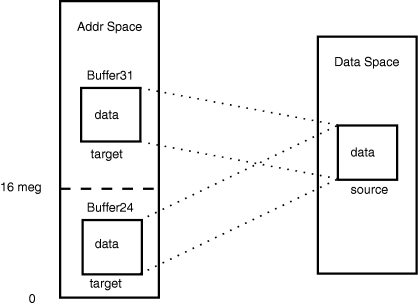Example of sharing storage with IARVSERV
Suppose you are updating a program called PGMA, that controls all the account deposits for a savings bank. Your program must work with two older programs that are complex and do not have source code available. The first program, called SUBPGMA, was updated six years ago and runs in 31-bit addressing mode; it records deposits in money market accounts. It cannot use data spaces. The other program, SUBPGMB, is much older and records deposits in standard savings accounts. It runs in 24-bit addressing mode. See Figure 1 for a representation of the storage.
Program PGMA, the main program, was written to keep all of its data in one large data space. PGMA must continually obtain appropriate storage in the address space that is addressed by SUBPGMA and SUBPGMB. After SUBPGMA and SUBPGMB finish, PGMA must copy all the updated data back to the data space. This is degrading performance and needs to be fixed. By using IARVSERV, you can eliminate the copying, and reduce the complexity of PGMA.
- PGMA creates a data space and initializes it with data.
- Before PGMA calls SUBPGMA to do a money market deposit, PGMA issues GETMAIN for storage in the private area for a buffer. This buffer is BUFFER31.
- PGMA issues IARVSERV SHARE to share the source in the data space with the target, BUFFER31. Use TARGET_VIEW=SHAREDWRITE so updates can be made directly into the data space.
- PGMA now calls SUBPGMA to update the data, passing the address of BUFFER31 as the area to be updated.
- Once SUBPGMA updates the data in BUFFER31, PGMA issues IARVSERV UNSHARE followed by FREEMAIN to release the storage.
- When PGMA needs to call SUBPGMB to do a savings account deposit, the only difference is that PGMA must obtain storage below 16 megabytes for the buffer. This buffer is BUFFER24.
- PGMA again issues IARVSERV SHARE with TARGET_VIEW=SHAREDWRITE, but identifies the target as BUFFER24.
- PGMA calls SUBPGMB to update the data, passing the address of BUFFER24 as the area to be updated.
- Once SUBPGMB updates the data in BUFFER24, PGMA issues IARVSERV UNSHARE and FREEMAIN to release the storage as before.
